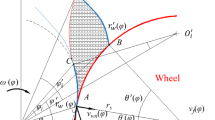Abstract
A simulation of the precision grinding of steel was performed using an implicit finite element code, namely the commercial code MARC, in order to describe the temperature fields developed during the process. The input data required a model obtained via a series of experiments, grinding several steels under the same grinding conditions in order to examine the effect of the workpiece materials on the temperature fields and the depth of the heat affected zones developed during grinding.






Similar content being viewed by others
Abbreviations
- a :
-
depth of cut
- a d :
-
depth of cut of dressing tool
- b s :
-
grinding wheel width
- [C]:
-
heat capacity matrix
- d s :
-
grinding wheel diameter
- f d :
-
feed of dressing tool
- \({{F}'_{t} }\) :
-
tangential force per unit width of workpiece
- h eq :
-
equivalent chip thickness
- [K]:
-
conductivity and convection matrix
- l c :
-
geometrical contact length
- \({{P}'_{t} }\) :
-
power per unit width of workpiece
- {Q}:
-
vector of nodal fluxes
- q :
-
heat flux
- R a :
-
average surface roughness
- {T}:
-
vector of nodal temperatures
- u :
-
total specific energy
- u ch :
-
energy required for chip formation
- v s :
-
peripheral wheel speed
- v w :
-
workpiece speed
- ε :
-
heat percentage induced in the workpiece
References
Jaeger JC (1942) Moving sources of heat and the temperature at sliding contacts. In: Journal and Proceedings of the Royal Society of New South Wales 76(3)
Outwater JO, Shaw MC (1952) Surface temperatures in grinding. Trans ASME 74:73–85
Des Ruisseaux NR, Zerkle RD (1970) Temperature in semi-infinite and cylindrical bodies subjected to moving heat sources and surface cooling. J Heat Tran 92: 456–464
Guo C, Malkin S (1996) Inverse heat transfer analysis of grinding, part 1: methods. J Eng Ind 118:137–142
Guo C, Wu Y, Varghese V, Malkin S (1999) Temperatures and energy partition for grinding with vitrified CBN wheels. CIRP Ann 48(1): 247–250
Moulik PN, Yang HTY, Chandrasekar S (2001) Simulation of thermal stresses due to grinding. Int J Mech 43:831–851
Mahdi M, Zhang L (1995) The finite element thermal analysis of grinding processes by ADINA. Comput Stru 56(2/3):313–320
Hoffmeister HW, Weber T (1999) Simulation of grinding by means of the finite element analysis. 3rd international machining and grinding conference, Society of manufacturing engineers
Malkin S (1978) Burning limit for surface and cylindrical grinding of steels. CIRP Ann 27(1):233–236
Snoeys R, Maris M, Peters J (1978) Thermally induced damage in grinding. CIRP Ann 27(2):571–581
Shaw MC, Vyas A (1994) Heat affected zones in grinding steel. CIRP Ann 43(1):279–282
Malkin S (1989) Grinding Technology: theory and applications of machining with abrasives. Society of manufacturing engineers, Michigan, USA
Zhang L, Mahdi M (1995) "Applied mechanics in grinding—IV. The mechanism of grinding induced phase transformation. Int J Mach 35(10):1397–1409
Chang CC, Szeri AZ (1998) A thermal analysis of grinding. Wear 216:77–86
Rowe WB, Petit JA, Boyle A, Moruzzi JL (1988) Avoidance of thermal damage in grinding and prediction of the damage threshold. CIRP Ann 37(1):327–330
Author information
Authors and Affiliations
Corresponding author
Appendix A
Appendix A
The mathematical formulations for the heat transfer analysis used by the implicit finite element code MARC are briefly outlined.
The heat transfer can be written as a differential equation
where [C] is the heat capacity matrix, [K] the conductivity and convection matrix, {T} the vector of the nodal temperatures and {Q} the vector of nodal fluxes. In the case of a steady state problem, where \({\dot{T} = {{\partial T} \over {\partial t}} = 0}\), the solution can be easily obtained by a matrix inversion as
In the case of transient analysis, where Ṫ≠0, which is the case described in the present work, the nodal temperature is approximated at discrete points in time as
In the MARC program a backward difference scheme is used to approximate the time derivative of the temperature
Substituting in Eq. 7, the vector {Q} is obtained as
Rights and permissions
About this article
Cite this article
Mamalis, A.G., Kundrák, J., Manolakos, D.E. et al. Effect of the workpiece material on the heat affected zones during grinding: a numerical simulation. Int J Adv Manuf Technol 22, 761–767 (2003). https://doi.org/10.1007/s00170-003-1685-z
Received:
Accepted:
Published:
Issue Date:
DOI: https://doi.org/10.1007/s00170-003-1685-z




